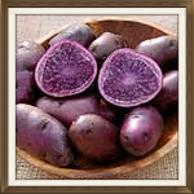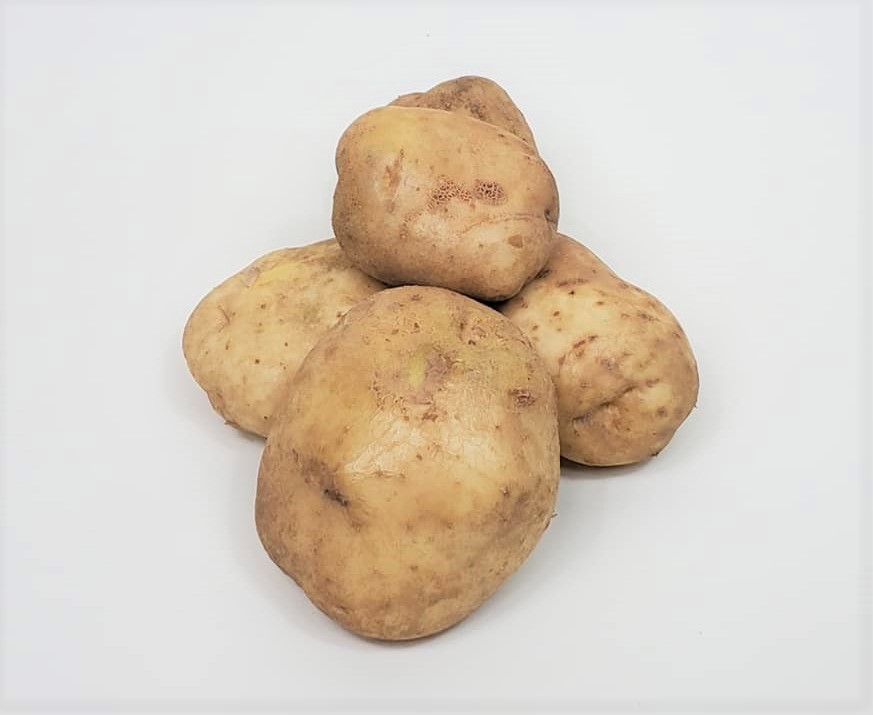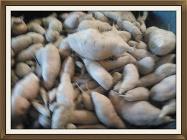MEADOWVIEW FARM & NATURAL HABITAT GARDENS, LLC
PRODUCT AVAILABILITY, PURCHASING AND PRICE LIST
NOVEMBER 2021
ASPARAGUS (Heirloom) $6.00/lb MARY WASHINGTON Available Spring 2022
After its release in 1919, 'Mary Washington' became the most popular standard asparagus variety grown.
It was bred by Dr. J. B. Norton of the U.S. Department of Agriculture and was one of his releases in the "Washington line" of asparagus varieties. The other varieties included 'Martha Washington' and 'Waltham Washington' but it was this variety, 'Mary Washington' that offered more uniform size and resistance to asparagus rust.
Although no longer used in commercial production, 'Mary Washington' is the parent stock of many of the modern hybrid varieties.
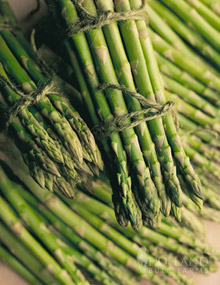
ASPARAGUS $6.00/lb PURPLE PASSION (F1) Available Spring 2022
Sweet, mild, and nutty flavor. With 20% more natural sugar, burgundy asparagus has sweeter stalks than green asparagus! These vitamin-rich spears are so tender, you can eat them right out of your garden. You’ll love the unique, nutty flavor. Stalks turn green when cooked.
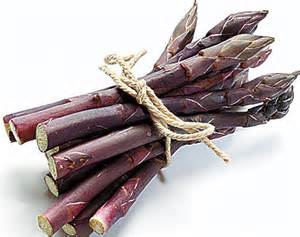
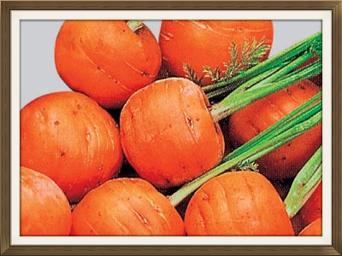
GARLIC $15.00 lb GEORGIAN CRYSTAL Sold Out Available May/June 2016
var. Porcelain –Characterized by fat bulbs with large cloves which are easy to peel. Boasts a medium flavor while raw; smooth and buttery when roasted; Georgian Crystal goes great with all types of meats. Table Stock/Eating Garlic
Often mistaken for elephant garlic because of its enormous pure white, densely wrapped bulbs. Rich garlic flavor and large, red, easy-to-peel cloves make this great roasting garlic. Stores well for a hardneck variety. Typically 4-6 cloves per bulb.
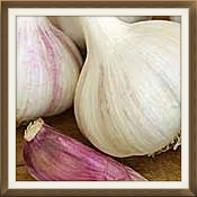
GREEN GARLIC $6.00 1/4 lb Available Spring 2022
Green garlic is simply immature garlic and looks like a slightly overgrown scallion or green onion. Use as you would green onions or garlic, noting that green garlic is milder than regular garlic.
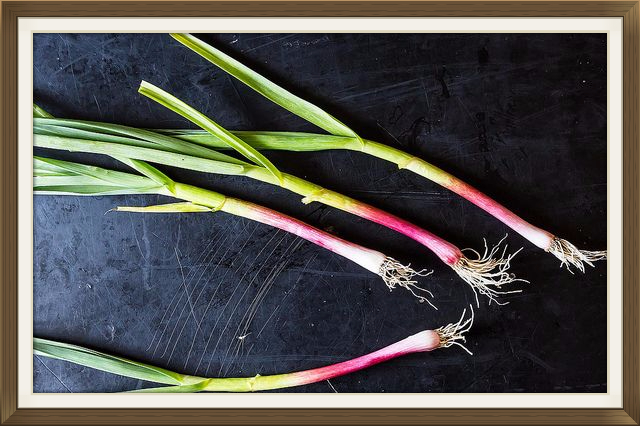
GARLIC $15.00 lb GERMAN WHITE Sold Out Available May/June 2016
var. Porcelain – Paper-white bulbs with tight wrapper skins. Plump cloves are porcelain- white with a distinctive, moderately spicy flavor. A late-season variety stores into the winter. Table Stock/Eating Garlic
The German White has a distinctive, moderately spicy flavor that sets this garlic apart from the rest. Plump cloves on paper-white bulbs, this is a great roasting variety, and stores well into the cold winter months. Typically 4-6 cloves per bulb.
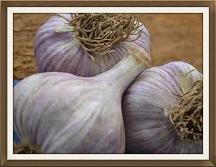
Garlic scapes are the "flower stalks" of hardneck garlic plants, although they do not produce flowers. They are usually cut off of the plant, since leaving them on only diverts the plants energy away from forming a plump bulb. If left on, they eventually form small bulbils that can be planted to grow more garlic.
Although garlic plants do not flower, they do produce flower stalks. On hardneck garlic, the stalks are known as garlic scapes and they are surprisingly tasty and versatile to use in the kitchen.
Garlic scapes start to form a month or so after the first leaves. They start off growing somewhat straight and then start curving in circles. Most gardeners cut the scapes off of their garlic plants, since leaving them on only diverts the plants strength and energy away from forming a plump bulb. If you leave them on, they will eventually form small bulbils that can be planted to grow more garlic, but it takes 2–3 years for them to form large bulbs.
Many gardeners simply toss their scapes in the compost, but garlic scapes are both edible and delicious, as are the bulbils. Along the same lines, young garlic plants that are pulled to thin a row are referred to as "green garlic". Used in the same manner as green onions, these too make excellent eating.
How to Use Garlic Scapes
If you harvest your scapes young and tender, you can chop them into salads or use them as a topping, as you would use scallions. More mature scapes can be sauteed lightly and used over pasta, with eggs, mixed with cooking greens, pickled or pretty much in any dish that would be complemented by garlic. My favorite way to use them is to make a garlic scape pesto.
SOURCE: http://gardening.about.com/od/herbsatoz/a/What-Are-Garlic-Scapes.htm
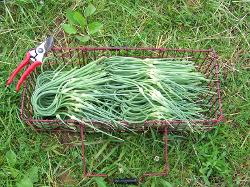
RED RUSSIAN KALE $4.00 1/4 lb
POTATOES
ALL BLUE BLUE POTATOES
With deep blue skin and flesh that almost appears purple, here is another potato to brighten your table and your favorite potato salad. A family favorite for making awesome French Fries or Oven Fries.
'EARLY OHIO' POTATOES Heirloom
This is a great all around potato. Very thin skinned so we never peel our eating potatoes since we grow without the use of any herbicides, pesticides or fungicides. We had no potato beetle pressure this year and we incorporated a double layer of cardboard and a tile of straw to our planting which reduced the weed pressure.
A favorite heirloom
Tan skin and delicate, pale flesh
Stores for up to 3-4 months
Tasty baked, boiled or fried
POTATOES (Heirloom) $8.00/lb OZETTE POTATOES (Ark of Taste selection) Late variety.
The Ozette potato came from Peru by way of Spanish explorers to the Makah Indians at Neah Bay, Washington in the late 1700s. It was rediscovered in the late 1980's to be a staple in the diet of the Pacific Northwest Native Americans of the the Makah Nation. The Makah Nation named the potato for a village located near Neah Bay. It was not until the late 1980's that the Ozette potato was catalogued and grown outside of the Makah Nation.
Originally, potatoes were taken from South America to Europe before they made their way to the America. However, it is believed that the Ozette was brought directly from South America to Neah Bay Washington by Spanish Explorers in 1791. They planted them in a garden that was later abandoned when the Spanish left. Discovered by the Makah people, they began to grow them in their own gardens and named them after one of their villages. Introduced to the market by David Ronniger in the late 1980's, the Ozette is one of the tastiest of all fingerlings. Classic in appearance with pale gold skin and creamy yellow flesh. The slightly earthy, nutty flavor comes through beautifully when lightly steamed or sauteed. A Slow Food USA, Ark of Taste selection.
Description/Taste
The Ozette potato is a petite heirloom fingerling type potato that grows to be between 3 and 7 inches in length. Its form, tubular and slightly lumpy is covered in a thin, tan colored skin speckled with brown freckling and deep set eyes. The flesh of the Ozette potato is creamy white and firm. When cooked, the Ozette develops a dense yet creamy texture and offers a rich, slightly sweet and earthy flavor with nuances of roasted chestnuts.
Seasons/Availability
Ozette potatoes are available late summer into the fall.
Current Facts
The Ozette potato, botanically known as part of Solanum tuberosum, is also known as Anna Cheeka’s Ozette and Makah Ozette. Though not a commercially successful variety, the Ozette has an important place in the potato history of North America as it is considered to be one of the only potatoes to come straight to North America via South America rather than first being taken to Europe by the Spaniards then later on to the Americas during European colonization. In 2006 Slow Food Seattle, the Makah Nation, the Seattle chapter for Chefs Collaborative, a handful of farmers, and a seed production laboratory for the USDA joined forces to increase production and further regional awareness of the Ozette variety in the Pacific Northwest. This successful campaign has made the Ozette seed available to multiple small farms and subsequently, the delicious potatoes it yields to nearby farmers markets and restaurants.
Nutritional Value
For over 200 years the Ozette potato provided an important source of carbohydrates and nutritional sustenance for the Native Americans of the Makah Nation. The potato additionally provides vitamin C and potassium as well as some dietary fiber, iron and vitamin B6.
Applications
Ozette potatoes can be utilized in preparations where fingerlings or petite potatoes are called for. They can be cooked with or without their skin on as the entire tuber is edible. Ozette potatoes are said to be at their best when steamed, pan-fried or roasted. Steam whole then crush slightly with a fork and brown in the oven dressed with olive oil and fresh herbs to enhance their naturally nutty flavor. Use halved in warm potato salads or grated and incorporated into potato pancakes. Halved or whole Ozette potatoes can be roasted simply with olive oil and sea salt then served as an accompaniment to grilled or roasted meats. Steamed Ozette potatoes can be mashed and used as a stuffing for savory hand pies and samosas or pureed and used to make potato bread. Like most potatoes the Ozette should be stored in a cool, dry and dark location until ready for use.
Ethnic/Cultural Info
For 200 years the Ozette potato was a staple crop in the diet of the Pacific Northwest Native Americans of the Makah Nation. The potato was given the name Ozette as an homage to one of the villages of the Makah Tribe located near Neah Bay where the potato was first grown in North America. Traditionally the Ozette potato was prepared by the Makah people roasted in a fire pit.
Geography/History
The Ozette potato first made its way to North America via Spanish explorers in the 1700s. The Spanish had been in South America and after their conquests there made their way to North America in efforts to expand their empire. In 1791, the Spanish established a fort at the most northwesterly point in the United States at Neah Bay in Washington State. As was customary at the time they planted a garden filled with crops they had brought from South America and Mexico, one of which was a potato that would later come to be known as the Ozette. After less than a year the Spanish abandoned the fort as severe weather made the harbor an unsuitable location for docking their vessels. The Makah Indians of Neah Bay maintained the gardens and quickly adopted the potato as it provided a much-needed source of carbohydrates. It was not until the 1980’s that the Ozette potato was cataloged and seed made available for growing outside of the Makah Nation. In 2005, the Ozette was recognized by Slow Food to be a historically significant potato and soon after a campaign was started in Washington State to increase awareness, seed availability, and usage of the potato throughout the Pacific Northwest. It is primarily grown today in home gardens and on a handful of small farms in the United States.
SOURCE: Specialty Produce
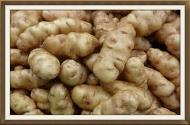
POTATOES $2.00/lb PURPLE VIKING POTATOES
Purple Viking excels as mashed potatoes, giving them a unique texture and taste that pleases with every bite. Also great in salads or as a baked potato. Purple Viking has all the characteristics of its parent Viking Red, but it has a true purple skin with pink-red splashes. Perhaps its most remarkable attribute is its snow white flesh with a very smooth texture.
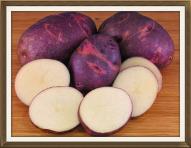
SWEET POTATOES $2.50/lb BEAUREGARD
These are absolutely the sweetest. No need for added sugar or butter, just bake in a 400 degree oven until cooked through and enjoy.
Harvested fall 2017.
Developed at Louisiana State University in 1987, this variety may be the world’s most popular sweet potato. It is favored for high yields of uniform, reddish-purple potatoes with tasty, deep-orange flesh that keeps well in storage. Exceptionally sweet!
SWISS CHARD (Heirloom) $4.00 1/4 lb VERDE DA TAGLIO
Green cut & come again. Very thin stems, incredibly sweet & tender leaves. Harvest outer leaves or simply cut the entire plant as it will regrow. Tastes as good as spinach. Spring, summer & fall; will overwinter in zone 5 in an unheated greenhouse or with some protection.
"Green Cutting Chard" Very thin stems support large leaves of unusual substance. Outstandingly sweet and tender variety. Excellent for "cut and come again" style harvesting. One of the best-tasting chards. A delightful, traditional Italian variety.
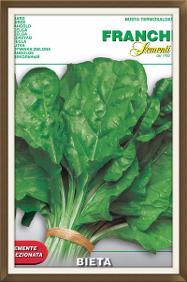
RADISHES (Heirloom) $3.00 bunch (5-8 oz) FRENCH BREAKFAST
A Paris favorite since before 1879. Beautiful scarlet-rose 1-2" long blunt roots with a bright white tip. Their crisp white flesh is mildly pungent, yet distinct.
Eye-catching deep pink roots with bright white tips and excellent eating quality. A French heirloom with oblong, blunt-tipped shape and healthy radish spiciness. Traditionally eaten raw with butter and salt or poached in butter served on sourdough bread with fresh herbs. Gourmet variety.
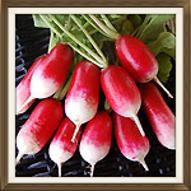
RADISHES $3.00 bunch (5-8 oz) RED HEAD Out of Season Available April/May 2016
Captivating, bicolored little globes have crystalline white bottoms and bright fuchsia crowns for an alluring complement to salads and crudités plates. The mild flavored roots are just as appealing to the palate as they are to the eyes, and are best when harvested at 1 inch in diameter.
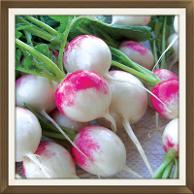
SPINACH $6.00 1/4 lb MATADOR
Dark green plant, very smooth leaves. Excellent taste. Nice for salad mixes.
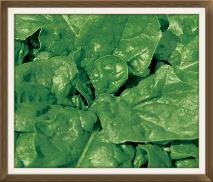
WHAT IT ALL MEANS
What makes a seed organic?
Certified organically grown seeds are harvested from plants raised on certified organic farms without the use of synthetic chemicals, pesticides, or herbicides. No chemical fungicides are applied to the seed before packing. Generated and tested under organic conditions, organic seeds are a fundamental first step in sustainable organic agriculture.
What is biodiversity?
Biodiversity is the sum total of all the genetic variation in the world's living organisms. Genetic variability is crucial to nature's ability to build resilience and resist extinction in the face of ever changing environmental conditions.
What are open-pollinated seeds?
Open-pollinated (OP) seeds are produced from plants that pollinate naturally through insects, wind, and water. This allows gardeners and farmers to save seeds that will reproduce true to the form of the parents if care is taken to prevent cross-pollination. OPs also allow us to create new varieties through cross-pollination and selection. Many seed companies sell mostly hybrids, which will not reproduce true-to-form from saved seed.
Meadowview Farm specializes in heirloom produce, beans and corn. Working with heirlooms is much more difficult than hybrid seed since they are more subject to disease, low yields, weather and pest damage. I want to maintain a sustainable operation which entails limited mechanical input, extensive manual labor, taxes, insurance and all other operational costs incurred so the above prices reflect the "real" cost of production on a small scale, sustainable farm operation. I receive no subsidies nor agricultural property tax credit since the farm is only 5 acres. If you believe in keeping the diversity of edible food crops and would like to experience the flavor offered by these heirlooms I would appreciate your support. --Lori
